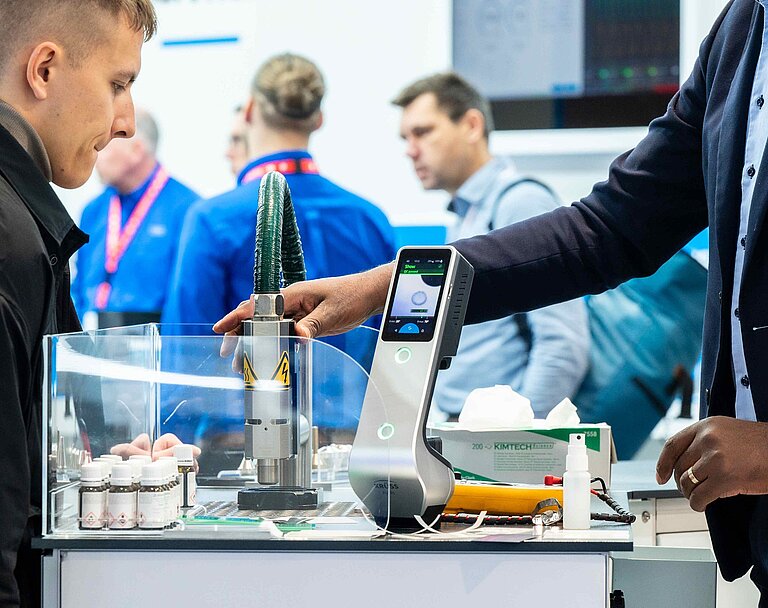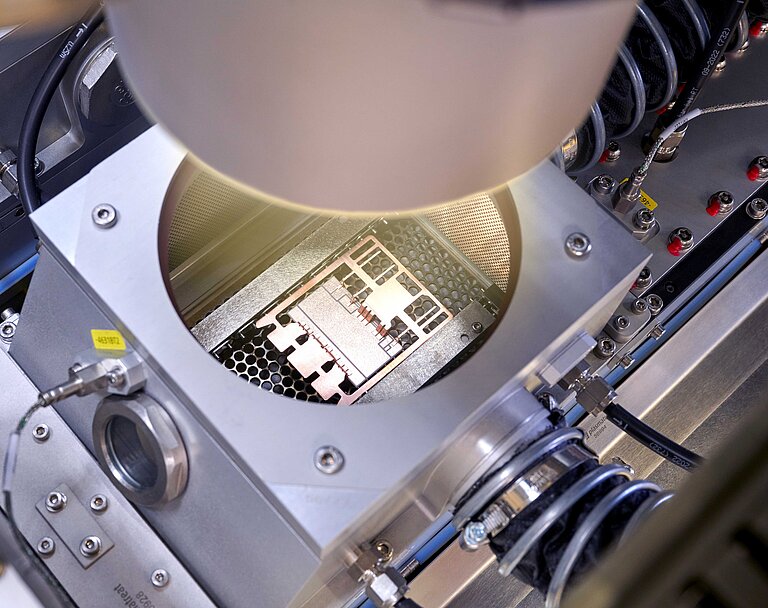Plasma Technology in Action – Live at PCIM Europe 2025
Power modules are the core of modern power electronics – whether in e-mobility, industrial automation, or renewable energy applications. From May 6–8, 2025, Plasmatreat will be showcasing how plasma technology can significantly enhance the performance and reliability of these critical components at PCIM Europe in Nuremberg.
At booth 169 in Hall 7, we’ll demonstrate live how oxide layers can be removed automatically and inline, and how our PlasmaPlus® coating technology effectively prevents delamination during overmolding. Visit us on-site and discover what future-ready surface treatment looks like – precise, cleanroom-compatible, and environmentally friendly.
Challenges in Semiconductor and Power Module Production

Tough Demands on Materials and Interconnections
High-performance power modules must operate reliably for years under extreme conditions. Whether in electric vehicles, wind turbines, or industrial drives, these components are exposed to high temperatures, high voltages, and intense mechanical stress – all within increasingly compact designs.
A particular challenge lies at so-called “triple points,” where different materials such as copper, ceramics, and potting compounds meet. These zones are prone to stress, trapped air, or adhesion failure – all of which can shorten the module’s lifespan. One of the root causes: oxidized metal surfaces that compromise solderability and increase contact resistance. Epoxy delamination during overmolding is another common risk. To address these issues, reliable interconnect technology and targeted surface treatment are essential.
Live Demo at PCIM Europe
Experience our plasma technology live at booth 169 in Hall 7. In a fully automated demo cell, we’ll showcase both REDOX-based inline oxide reduction and functional nanocoating with PlasmaPlus® – all under realistic production conditions.
A highlight of our exhibit is the robot-controlled Plasma Treatment Unit (PTU), which allows for accurate, non-contact treatment of even complex geometries. At our interactive plasma demonstration table, you can see and feel the effects of plasma treatment for yourself – from surface cleaning and activation to improved wettability.
Our on-site experts are available to advise you on how our technologies can be tailored to your specific applications and processes.

Use Cases – Where Plasma Makes the Difference
Application Areas Across High-Demand Industries
Our plasma systems are used wherever power modules are exposed to extreme conditions and need to perform reliably. Different industries face different challenges – but the solution remains the same: advanced surface treatment with Openair-Plasma® and PlasmaPlus®.
E-Mobility
In inverters, battery management systems, and charging units, plasma ensures stable electrical contacts and prevents delamination in highly dynamic environments with intense heat and current loads.
Renewable Energy
Photovoltaic and wind energy systems require long-term durability despite exposure to UV radiation, moisture, and temperature swings. Plasma coatings help protect critical contact areas and improve reliability.
Industrial Automation
Power modules in industrial and robotic systems must withstand vibration, dust, and harsh media. Plasma treatment improves adhesion of potting compounds and ensures long-lasting, high-integrity connections.
The Exhibition Warm-Up: Power Module PlasmaTalk Now Online
Key challenges include:
Voids in Solder Joints
- Thermal and Electrical Impedance: Voids can reduce the thermal and electrical conductivity of solder joints. This can lead to hotspots, increased resistance, and potential failures due to overheating.
- Mechanical Weakness: Voids compromise the mechanical integrity of solder joints, making them more susceptible to cracking and failure under thermal and mechanical stress.
Oxidation of Metal Surfaces
- Poor Adhesion: Oxidized surfaces hinder proper bonding between materials, which can result in delamination or poor mechanical strength of the assembled components.
- Inconsistent Soldering: Oxides create barriers that prevent solder from wetting and spreading uniformly, leading to weak and unreliable solder joints.
Material Compatibility
- Thermal Expansion Mismatch: Different materials have different coefficients of thermal expansion. Without proper surface treatment and bonding techniques, thermal cycling can cause stresses that lead to delamination or cracking.
- Chemical Incompatibility: Materials must be carefully selected and treated to prevent chemical reactions that can degrade performance or cause failures.
Flux Residue
- Contamination: Flux residues can contaminate the assembly, leading to electrical shorts, corrosion, and reliability issues.
- Cleaning Challenges: As components become smaller and more densely packed, removing flux residues without damaging the components becomes increasingly difficult.
Miniaturization
- Precision Requirements: Smaller components and finer pitches require extremely precise manufacturing processes. Even minor imperfections can lead to significant performance issues or failures.
- Heat Dissipation: Efficient heat dissipation becomes more challenging as the size of components decreases, necessitating high-quality solder joints and materials to manage heat effectively
Long-Term Reliability
- Environmental Exposure: Power electronics are often exposed to harsh environments, including high temperatures, humidity, and vibration. Ensuring that all materials and joints are free from voids and defects is critical for maintaining long-term reliability.
- Aging and Degradation: Over time, materials can degrade, and joints can weaken. Voids and imperfections accelerate this process, leading to early failures.

Addressing these challenges
Techniques such as the Openair-Plasma® technology and the REDOX-Tool's inline oxide reduction can effectively clean and prepare surfaces, ensuring that all materials bond properly and function reliably even under the high demands of power electronics.
This results in improved electrical performance, higher yield rates, and enhanced overall reliability and longevity of the components.





